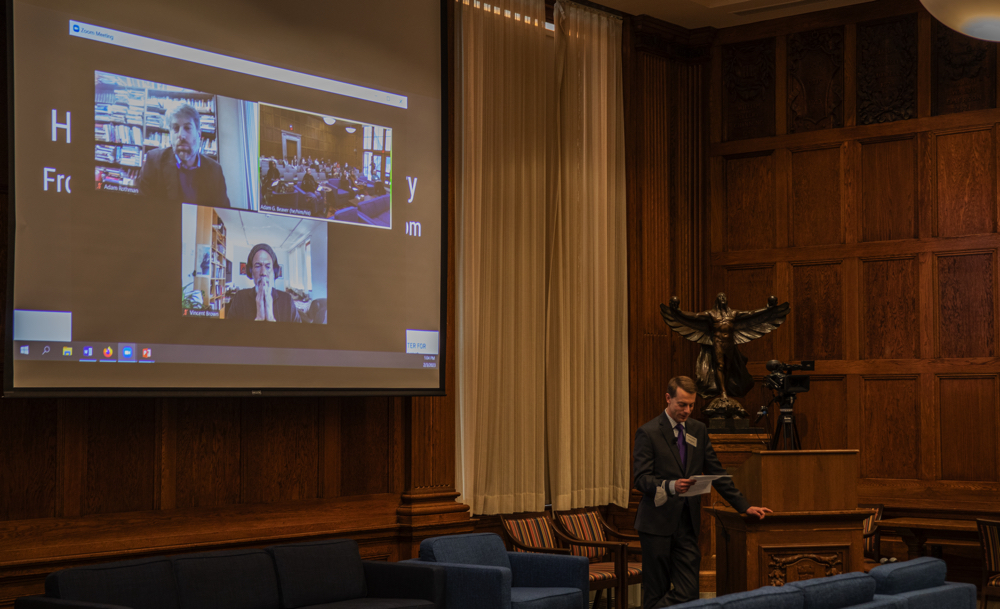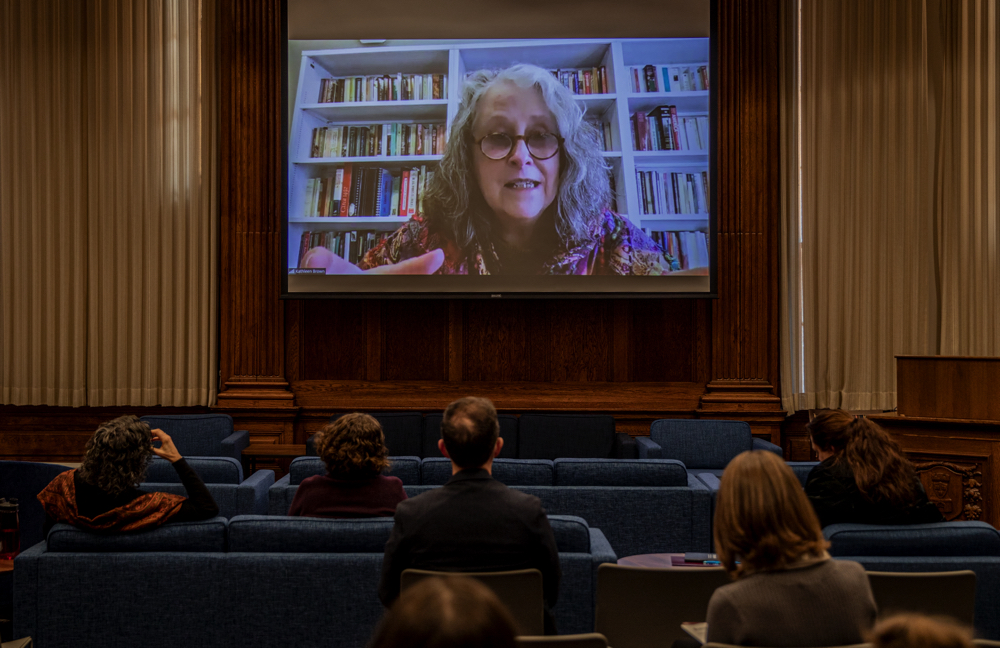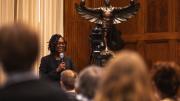Not quite a year after Harvard laid bare its historic ties to slavery in a detailed 134-page report, a small group of faculty members and teaching staff gathered on campus late last week for a two-day seminar on how to integrate that report’s findings into their own curricula. “Harvard and the Legacy of Slavery: From the Committee Report to the Classroom” was hosted by the Derek Bok Center for Teaching and Learning, and it drew participants from across campus: in history, literature, classics, anthropology, music, and medicine, from the Graduate School of Education, the Harvard School of Design, Harvard’s libraries, and the Harvard Art Museums, among others.
“One of our goals,” said Adam Beaver, the Bok Center’s director of pedagogy and the seminar’s principal organizer, was “to help Harvard faculty imagine the kinds of obstacles and opportunities that would come with incorporating the findings and questions raised by the Presidential Initiative [on Harvard and the Legacy of Slavery] into their own teaching.” A second seminar, building on the ideas from this one, will take place in March.
In her introductory remarks, Sheree Ohen, associate dean of diversity, inclusion, and belonging in the Faculty of Arts and Sciences, laid out the stakes of the courses and lessons that will emerge from the Harvard report. “I mean, where else in a curriculum does a student have a chance to write a paper that prompts a school to be renamed or that endows a social justice initiative?” she said. “So, not only is this a remarkable opportunity for you as faculty, researchers, lecturers, and others that support the academic experience, but it also comes with a lot of responsibility.”
The program’s six speakers (who addressed attendees via video) were all scholars who had helped lead efforts to uncover their own institutions’ past entanglements with slavery: Princeton historian Martha A. Sandweiss ’75, University of Pennsylvania historian Kathleen M. Brown, Georgetown historian Adam Rothman, and cultural studies scholar Laura Goldblatt from the University of Virginia. Speaking from Harvard were Warren professor of American history and professor of African and African American studies Vincent Brown, who served on the presidential committee that produced Harvard’s report; and Bell professor of history Sven Beckert, who in 2007 began teaching a series of undergraduate seminars that became the genesis of the University’s own research project investigating its history with slavery. Beckert and his students unearthed many of the revelations that would eventually make their way into the report.

Photograph by Casey Cann of the Bok Center
Last week, Beckert spoke first, offering an abbreviated summary of his and his students’ 16-year journey: how the early research they conducted—not knowing what they would find or if they would find anything at all—grew into a critical mass of startling discoveries that attracted the attention of former president Drew Faust and, eventually, the support of Harvard’s administration. “For me, personally, this was the most rewarding teaching I’ve ever done in my life,” Beckert said. “It was beautiful because it did in some ways undermine the division between me, being the teacher telling them how the world works, and the students.” Especially in the beginning, the information covered in class was as new to him as it was to them. “When you teach these kinds of courses, you're not dreading the moment when you have to grade the paper; it's just the opposite,” he said. “You can't wait to read the paper, because there's going to be something in it that you don’t know, that is probably going to make you rethink the problem that you're engaging with….It’s an ideal way to teach.”
That sentiment was echoed in different ways by other speakers, all of whom have collaborated closely with students on this kind of research, both in and out of the classroom. “We were producing the knowledge we needed,” said Princeton’s Sandweiss. “I could never say at the beginning of any one semester what we would collectively know at the end.” Again and again, panelists referred to their students as not merely learners, but “producers” and “creators” of knowledge. And although much more is now known and documented about the institutions’ connections to slavery, there are still many questions left to be answered, as well as deeper layers of inquiry expanding on previous research. Kathleen Brown, who has led the Penn and Slavery Project since 2017, described how student reports are posted to the project’s website, “and then the website becomes part of the classroom materials” for each new incoming cohort of undergraduates. “So, they do have a sense of a kind of community of researchers that's now five years deep,” Brown said. “And that’s really important. They write the reports leaving a breadcrumb trail of what they’ve looked at.”
At Georgetown, Rothman’s students have produced maps, podcasts, songs, poems, artworks, and websites from their research, as well as more traditional reports. “Each of these projects is itself a useful set of pedagogical tools,” he said. “I use each of these projects in my teaching, now that they’re out in the world. And if the students know that a project could potentially influence future generations and cohorts of students, I think they take them much more seriously, and really invest themselves in this progress.”
But what happens, asked a librarian in the audience, when students do the research but don’t make progress, because the information they are seeking—about the last name or life story of an enslaved person, for instance—simply isn’t in the archival record? “There’s something about the impossibility of the assignment,” the librarian said. “How do you make a story out of that?”
Rothman answered that courses like the ones he teaches, structured around open questions and live research, require a different definition of what it means to complete an assignment. “We have to allow our students to fail in their projects, and in failure to succeed at something else,” he said. “The challenge of grading these projects is immense—that’s a whole other conversation. But somehow, in our standards of what a successful project is, we have to accept the possibility that students might fail, and that can be OK.”
Another theme kept echoing through the conversations, tied to students’ role as knowledge producers: in these courses, students were writing not only for their classmates and professors, but for the public. Beckert and his students launched their own website and a series of videos long before the University embraced the project, and in 2011, they published a booklet of their findings, Harvard and Slavery: Seeking a Forgotten History. Sandweiss described how the decision to create a website three years into Princeton’s project transformed her students’ commitment. The website “really flipped things for the students,” she said. “Suddenly, they can see that their work will be put up online, for all the world to see.” Initially, some students had felt frustrated by the lack of existing research, “But knowing that people will read your work, that turned it around for them. It also required students to adopt a particular kind of public-facing style of writing, and it was fun to work with them on that.”
Kathleen Brown said that the research at Penn was conceived from the start not as a classroom seminar, but a student-driven public-facing effort intended to engage the broader Philadelphia community. “From the very beginning,” she said, “I urged [students] to think hard about how they knew what they knew, and to take responsibility and be accountable, so that when they stood up in a public presentation, or went to a class, or we had a meeting with administrators at the university, we felt that we were on sure ground—that it was not just me, and them following along behind me, but them in and of themselves assuming a more mature role in taking responsibility as knowledge producers in this endeavor.”

Throughout the seminar, participants dove into a range of other questions and problems. More than once, the subject of universities’ involvement in indigenous slavery—a relatively less-studied area—came up. Harvard’s report does begin by citing the dispossession, massacre, and enslavement of Indigenous people during the early colonial period (including an account of a slave ship that sailed from Marblehead in 1636, carrying Pequot war prisoners to be sold into slavery in Bermuda on the instructions of John Winthrop, governor of Massachusetts Bay Colony and a member of Harvard’s founding committee); and an appendix listing the individuals enslaved by Harvard affiliates includes Native Americans. But the bulk of the report, as with research at other universities, focuses on African slavery and its legacies.
One participant asked about how to handle classroom situations in which it’s clear that digging into traumatic histories will disproportionately affect some students, especially those whose family lineages and ethnic backgrounds are implicated in the research. “How do we provide support or care, or just understanding?” he asked. “How do you think about that, as historians and pedagogues?”
“I don’t have a perfect answer to that,” Beckert said. “There were moments when we all had tears in our eyes when the students reported certain really horrific things that they found in the archives. Unlike other teaching, there were moments of silence in our conversation, when nobody really knew what to say next. And that, in a way, I think gave all of us the opportunity to process what we had found.” It also helped, he added, that the research was part of a larger active push—first, for recognition from the University, and ultimately, for a process of reckoning and repair, which is now under way. “It wasn't just learning about terrible things in the past; we also did something about it,” Beckert said. “We produced knowledge that we hoped would make a difference. So, this was a scholarly project, but it did also have that dimension to it, a promise to make a difference in the real world.”
In other discussions, it became clear the difference it makes to these projects to have university buy-in. Goldblatt, at the University of Virginia, talked about how her students’ archival research had been embraced by the administration and incorporated into the general education curriculum mandated for all undergraduates. This created unexpected challenges: overlapping requirements meant students were expected to take a walking tour of slavery-connected campus sites multiple times a year, which some of them found “re-traumatizing,” Goldblatt said; and professors in fields like astronomy have struggled with how to integrate the historical findings into their lesson plans. But “the fact that we had these activities available meant that there was a way for students to understand the history of white supremacy at the University of Virginia—and the ways it has continued,” Goldblatt said. “It also gave everyone a common language. I’ve had some [students of color] say to me they appreciate that, because they didn’t feel like they had to speak for their entire race.”
Sandweiss, on the other hand, said that the research project she and her students created at Princeton has never received support or formal acknowledgement from the university. “I continue to hope that our historical work will provide the undergirding for a meaningful institutional response someday,” she said. “And the in meantime, I hope it remains a rich teaching source for my many, many colleagues.” But even without this support, she added, “My goal was always just to have our work become part of the university DNA, something every student learns about as part of their introduction to campus. And, slowly, that is happening.” At the same time, the lack of official recognition means greater flexibility: “We can operate with a kind of under-the-radar freedom that I think has led to some very successful community partnerships.”
The final session focused on the idea of “telling the story”: helping students turn archival research into public narratives. Throughout the seminar, one idea that kept surfacing was the various registers that research like this moves across: local and global, past and present, scholarship and politics—and how the connections between those things helps engage students (and the wider community) in the work. In his remarks, Vincent Brown, a filmmaker as well as a historian (and, on occasion, a creator of narrative cartography), talked about reckoning and responsibility, about storytelling as a form of “stewardship,” about the impossibility of standing apart from history, and about the relationship between content and form.
Then he told a story about Isaac Royall Sr., a slave trader and sugar plantation owner on the Caribbean island of Antigua (whose son, Isaac Royall, Jr., bequeathed the founding gift for Harvard Law School). In 1736, a major slave rebellion took place on Antigua, and the elder Royall’s driver, a man named Hector, was implicated in the conspiracy. After his execution, the family received 70 pounds in compensation for their lost property. “Now, I don’t know exactly how much that would be in today’s dollars, but it’s pretty clear that some portion of that gift to Harvard University was derived from compensation for the executed conspirator on Isaac Royall’s family plantation in Antigua,” Brown said. “Which takes our history out beyond the history of this local area in New England, beyond the history of the United States, out to the history of the Caribbean and even the Atlantic world.”
The Royalls, and the gift to the University, are familiar subjects on campus; a few years ago, they were at the center of a furious controversy and successful movement to remove the Royall family crest from the Law School’s seal. “But we never think about Hector,” Brown said. “And we never think about the dispossession of Hector’s family upon his execution. How is it that we are going to commemorate and tell that story as a part of this story of Harvard? Or are we going to continue to keep it separate? Those are the kinds of questions that I think we have to wrestle with.”









